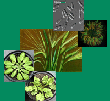| Beck, E; Senser, M; Scheibe, R; Steiger, HM; Pongratz, P: Frost avoidance and freezing tolerance in afroalpine giant rosette plants, Plant, Cell and Environment, 5, 215-222 (1982), doi:10.1111/1365-3040.ep11572080 | |
| Abstract: The large leaf rosettes of the so‐called ‘giant rosette’ plants which inhabit the alpine region of tropical mountains are composed of a great number of adult leaves surrounding a central cone of developing leaves. Upon onset of the nocturnal frost period the adult leaves nyctinastically bend inwards and form a night‐bud around the central leaf bud. The insulating effect of the night‐bud was analysed in four species: Senecio keniodendron, Senecio brassica. Lobelia keniensis and Lobelia telekii which grow on Mt Kenya (Kenya). Freezing is avoided by a delay of cooling which is sufficient until rewarming by the next day's sunshine. A consequence of this delay is that the temperature in the nocturnal bud remains higher than that of the outer leaves which are often stiffly frozen after cold nights. Only one freezing point was detected on the leaf temperature recordings. Depending on the water state, the freezing points were in the range — 1°C to —4.2°C. Sucrose, amounting to 38% of the leaf dry weight, may act as a cryoprotectant for the cell membranes. Frost hardiness of the leaves, as determined with a laboratory method, was sufficient to enable the plants to survive during the nocturnal frost temperatures as measured in the field. |

